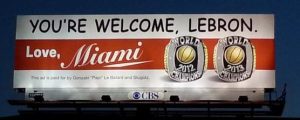The perception of ESPN and the UFC may vary by audience, but there’s no denying they’re both using the same playbook when it comes to staying on top of the news cycle and the social media/network activity that swirls around whatever story is enjoying its 15 minutes of fame. In the span of a few days, both the ‘worldwide leader’ and the dominant promotion in mixed martial arts (MMA) fighting pounced the same way to extend publicity opportunities that were either wholly fabricated or the obvious result of their own actions.
 Dan LeBatard*, a Miami-based host of ESPN television and radio shows, was the brains behind a stunt that successfully attached itself to LeBron James‘ coattails, giving life to the faux controversy of the NBA superstar not publicly thanking his former home (and, presumably, its fans) for the success he had four years after taking his talents to South Beach.
Dan LeBatard*, a Miami-based host of ESPN television and radio shows, was the brains behind a stunt that successfully attached itself to LeBron James‘ coattails, giving life to the faux controversy of the NBA superstar not publicly thanking his former home (and, presumably, its fans) for the success he had four years after taking his talents to South Beach.
Trolling for reaction is a tool often used to generate what used to be called “water cooler conversation” (back when people actually spoke directly to each other), so LeBatard shouldn’t be faulted for feeding our pop culture-obsessed society what it likes to eat. But that’s exactly what the network did (wink wink) by announcing it was suspending its employee two days for actions that didn’t properly “reflect ESPN’s standards and brand.” Not coincidentally, their manufactured outrage helped prolong the story’s lifespan and take it to audiences far beyond those who follow the NBA or its teams in South Florida and Ohio.
Meanwhile, at the Ultimate Fighting Championship, it’s time to promote (read: sell tickets and pay per view buys) UFC 178, which is being headlined by a championship bout between Jon “Bones” Jones and Daniel Cormier. To do this, the promotion sets up a photo op known as the ‘stare down,’ where the two fighters literally get nose to nose while cameras record and breathless media pontificate about the intensity of the encounter.  As you can probably guess, sometimes one or both of the combatants take offense with the actions of the other and, being fighters, respond in a physical way, which is what happened between Jones and Cormier. The ensuing melee spilled off the makeshift stage, knocking over banners and chairs to produce video that would make even Don King or the WWE proud.
As you can probably guess, sometimes one or both of the combatants take offense with the actions of the other and, being fighters, respond in a physical way, which is what happened between Jones and Cormier. The ensuing melee spilled off the makeshift stage, knocking over banners and chairs to produce video that would make even Don King or the WWE proud.
Nothing sells in combat sports like the belief that real hatred exists between fighters and the UFC has marketed that, whenever possible, since its earliest days. That’s why their reaction following the incident — that Jones and Cormier violated the organization’s code of conduct (no fighting unless we’re getting paid, the code must state) and that they were “prepared to levy sanctions to reinforce the appropriate behavior” — is nothing more than an attempt to raise awareness of the bad blood between the two while customers are deciding whether to spend on UFC 178.
By feeding media’s need for content and providing online audiences the materials to post, share, tweet, and comment on, the two sports-focused entities bought themselves at least another ’15 minutes’ that will be repaid many times over in larger audiences and advertiser/sponsor revenue.
An effective promotional strategy to be sure, if not the most honest. LeBatard, for his part, didn’t overplay the charade like his employer did. “This is a publicity stunt disguised as a movement. Please don’t tell anyone there is no actual movement.”
# # #
* Full disclosure: I’ve known and worked with Dan LeBatard since the late 1980s, when he was a Miami Herald reporter and I was producing shows at WQAM, South Florida’s first all-sports radio station.

